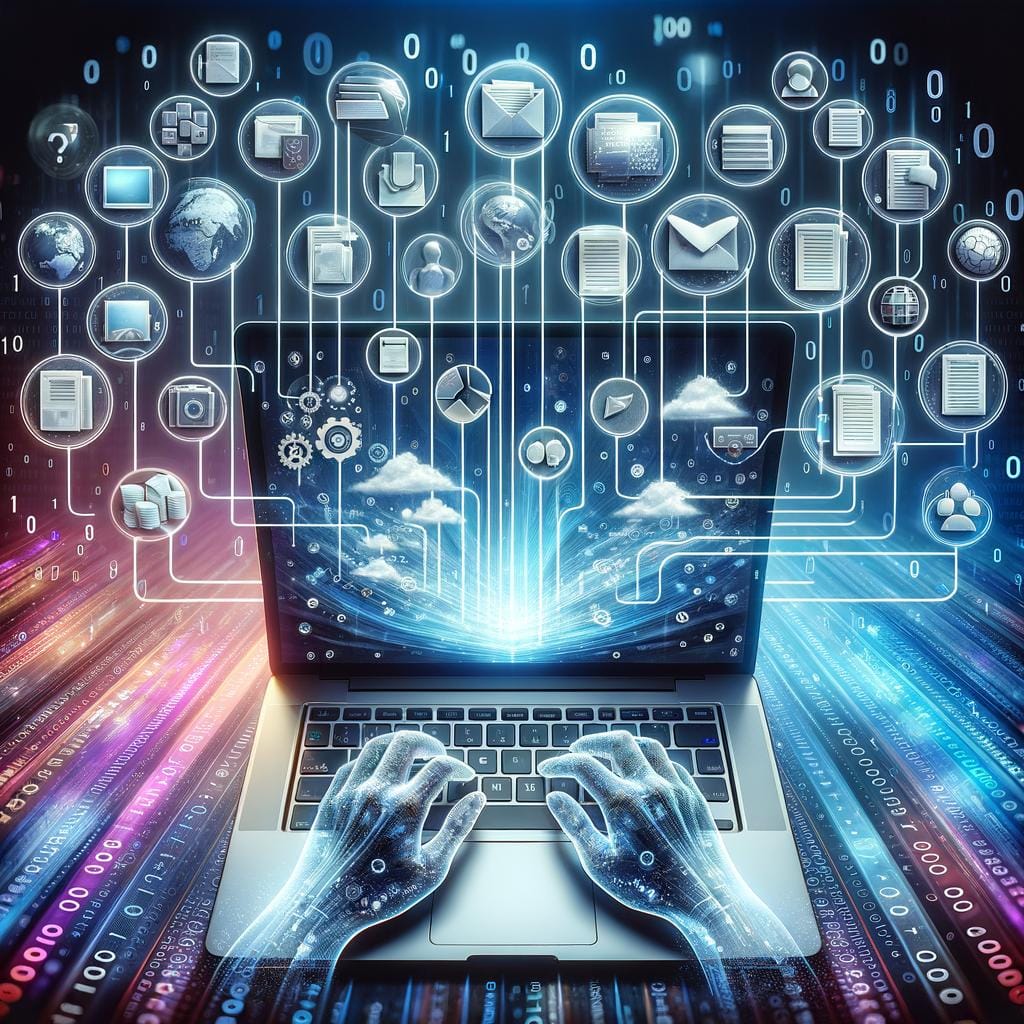Living a minimalist digital life has become increasingly important in today’s fast-paced and technology-driven world. The concept of minimalist digital life focuses on simplifying our relationship with technology, reducing digital clutter, and achieving a more mindful and intentional approach to our online activities. In a time where constant connectivity and information overload are prevalent, embracing minimalism in the digital realm can lead to greater focus, reduced stress, and overall improved well-being.
By consciously choosing to declutter our digital spaces, we can experience numerous benefits such as increased productivity, better organization, and a sense of calmness. Streamlining our digital files, emails, and apps can help us eliminate distractions and prioritize what truly matters. This not only saves time but also allows for a clearer mind free from the overwhelm of excessive information.
As we navigate the digital landscape, it is essential to adopt minimalist digital tools that align with our values and goals. By utilizing minimalist apps and software designed for productivity and mindfulness, we can optimize our online experience while minimizing unnecessary features or distractions. Embracing digital minimalism in social media usage by curating our feeds and limiting screen time can also contribute to a more intentional online presence and healthier relationship with technology.
Benefits of Embracing a Minimalist Digital Life
In today’s fast-paced digital world, embracing a minimalist digital life has become more important than ever. A minimalist digital life involves consciously simplifying and decluttering your online presence to focus on what truly matters. By reducing unnecessary digital noise, individuals can experience numerous benefits that positively impact their overall well-being.
One significant advantage of a minimalist digital life is the reduction of clutter in your virtual spaces. Just like decluttering physical spaces can create a sense of calm and organization, streamlining your digital files, emails, and apps can lead to a more efficient workflow and improved productivity. With fewer distractions popping up on your screen, you can better concentrate on the task at hand.
Moreover, embracing a minimalist digital life can enhance your focus and concentration. By eliminating excess notifications, apps, and online commitments, individuals can direct their attention towards activities that align with their priorities. This increased focus not only boosts productivity but also promotes mindfulness in daily interactions with technology. Overall, by intentionally curating your digital environment, you are creating space for meaningful experiences both online and offline.
| Advantages of Minimalist Digital Life | Benefits |
|---|---|
| Reduction of clutter | Calmer workspace and improved productivity |
| Enhanced focus | Increased concentration on priorities and mindfulness |
Decluttering Digital Spaces
In today’s fast-paced digital age, it’s easy to accumulate a staggering amount of digital clutter. From overflowing email inboxes to disorganized files on your computer and a plethora of unused apps on your phone, the chaos in our digital spaces can be overwhelming.
Embracing a minimalist digital life is crucial for maintaining productivity, reducing stress, and fostering mental clarity. By decluttering your digital spaces, you can streamline your online interactions and create a more efficient and harmonious relationship with technology.
One effective strategy for decluttering your digital spaces is to start by organizing your files and emails. Create specific folders on your computer or cloud storage system to neatly categorize documents, photos, and other digital assets. Implementing a consistent naming convention will make it easier to locate files quickly when needed.
Similarly, take the time to sort through your email inbox and unsubscribe from unnecessary mailing lists. Deleting irrelevant emails and organizing important ones into folders can help reduce visual noise and improve your overall online experience.
When it comes to decluttering apps on your devices, consider uninstalling those that no longer serve a purpose or bring value to your life. By minimizing the number of apps on your phone or tablet, you can decrease distractions and boost focus.
Organize the remaining apps into relevant categories or screens to create a more streamlined digital environment. Adopting these practices as part of your minimalist digital life approach can lead to increased efficiency, reduced decision fatigue, and a heightened sense of control over your technology usage.
| Benefit | Example |
|---|---|
| Increased Productivity | Decluttered files allow for easier access to important documents |
| Reduced Stress | Clean email inbox leads to less overwhelm when checking emails |
| Better Focus | Organized apps minimize distractions during work or leisure time |
Minimalist Digital Tools
Living a minimalist digital life involves not only decluttering your digital spaces but also utilizing minimalist tools that can enhance productivity and promote mindfulness. By incorporating these tools into your daily routine, you can streamline your digital experience and create a more intentional relationship with technology. Here are some recommendations for minimalist apps and software that can help you achieve a more balanced and focused digital life:
- Todoist: This app is perfect for organizing your tasks and to-do lists in a simple and efficient manner. With its minimalist design, Todoist allows you to prioritize your tasks, set reminders, and track your progress easily.
- Forest: If you’re looking to reduce distractions and increase focus, Forest is the app for you. This productivity tool uses gamification to help you stay off your phone by planting virtual trees that grow as long as you resist the temptation to check social media or messages.
- Calm: For those seeking mindfulness and relaxation in their busy digital lives, Calm is an excellent app for meditation, sleep stories, and soothing sounds. Its minimalist interface provides a tranquil space for practicing self-care and improving mental well-being.
These minimalist tools not only simplify your digital interactions but also encourage mindful usage of technology. By incorporating them into your routine, you can optimize your productivity while fostering a greater sense of awareness and balance in your digital life. Remember, the key to embracing a minimalist digital lifestyle is not just about decluttering but also about choosing tools that support your well-being in the digital world.
Digital Minimalism in Social Media
In a world where social media has become an integral part of daily life, it’s essential to incorporate minimalist principles into our online interactions. Creating a minimalist digital life extends beyond decluttering digital spaces and organizing files-it also involves streamlining our social media usage for a more intentional online presence.
By implementing strategies to simplify and enhance our time spent on social platforms, we can foster healthier relationships with technology and cultivate a more mindful approach to our digital experiences.
Here are some practical tips for practicing digital minimalism in social media:
- Audit your social media accounts: Take stock of all the platforms you’re active on and consider which ones truly add value to your life. Consider decluttering by deleting inactive accounts or unfollowing accounts that no longer resonate with you.
- Limit your time: Set boundaries on how much time you spend on social media each day. Use tools like screen time trackers or app limits to help you stay within your designated usage limits.
- Curate your feed: Take control of the content you see by curating your feed to include accounts that inspire, inform, or entertain you. Unfollow accounts that contribute to negative emotions or distractions.
By incorporating these practices into your social media routine, you can create a more purposeful and enriching online experience. Remember that digital minimalism isn’t about completely eliminating social media from your life but rather about using it intentionally and mindfully to enhance your overall well-being in the digital age.
Setting Boundaries With Technology
In today’s fast-paced digital world, setting boundaries with technology has become more crucial than ever in maintaining a healthy balance between our online and offline lives. Establishing limits on screen time and digital distractions is essential for promoting mindfulness, reducing stress, and enhancing overall well-being.
The Importance of Setting Boundaries
The constant barrage of notifications, alerts, and endless scrolling can easily consume our attention and drain our mental energy. By setting boundaries with technology, we can regain control over our digital habits and prevent technology from overwhelming our lives. Creating limits on screen time not only helps us to be more present in the moment but also allows us to prioritize activities that truly matter to us.
Practical Strategies for Limiting Screen Time
One effective strategy for establishing boundaries with technology is to set specific time blocks for device usage. This could involve designating certain hours of the day as tech-free zones or implementing periods of digital detox where we disconnect from screens entirely.
Additionally, utilizing features like screen time tracking tools or app blockers can help monitor our usage and limit distractions when necessary. By being intentional about our technology use, we can reclaim our time and focus on what truly adds value to our lives.
Cultivating Mindful Tech Habits
Incorporating mindfulness practices into our daily routine is another powerful way to set boundaries with technology. By being aware of how we interact with digital devices and the impact it has on our well-being, we can make conscious choices that align with our values and priorities.
Engaging in mindful tech habits such as taking regular breaks, practicing deep breathing exercises before checking emails or messages, and implementing digital curfews before bedtime can help promote a healthier relationship with technology. Embracing a minimalist digital life through mindful consumption can ultimately lead to greater focus, productivity, and fulfillment in all areas of our lives.
Digital Detox Practices
In today’s fast-paced and constantly connected world, it can be easy to become overwhelmed by the digital noise that surrounds us. This is where the concept of a minimalist digital life comes in – a lifestyle choice that focuses on simplifying our digital interactions to create more balance and peace of mind.
Embracing a minimalist digital life involves consciously reducing the amount of time spent online, decluttering digital spaces, and setting boundaries with technology. By taking steps to unplug and reset our digital habits, we can regain control over our screen time and find greater clarity in our daily lives.
One of the key benefits of practicing a minimalist digital life is the ability to engage more fully in real-world experiences without constant distractions from technology. By incorporating regular digital detox practices into our routine, such as unplugging for a set period each day or taking breaks from social media, we can give ourselves the space to recharge and reconnect with the world around us.
This intentional break from technology allows us to clear our minds, reduce stress levels, and improve mental well-being.
It’s important to remember that taking a step back from our devices doesn’t mean completely cutting off from the digital world. Instead, it involves finding a healthy balance between offline and online activities.
By prioritizing meaningful connections, pursuing hobbies outside of technology, and being mindful of our screen time, we can cultivate a more balanced lifestyle that nourishes both our physical and mental health. In today’s hyper-connected society, embracing a minimalist digital life is not just about decluttering our screens – it’s about reclaiming control over how we interact with technology to lead a more intentional and fulfilling life.
Balancing Offline and Online Life
In today’s fast-paced digital world, finding a balance between our online and offline lives has become increasingly important. The concept of a minimalist digital life involves reassessing our relationship with technology and striving for a healthy equilibrium between screen time and real-world experiences. By consciously managing our digital consumption, we can reap the benefits of technology while also prioritizing meaningful interactions and activities in the physical world.
The Importance of Balance
Embracing a minimalist digital life allows individuals to avoid the pitfalls of excessive screen time and digital distractions. By establishing boundaries with technology, we can allocate more time to engage in face-to-face conversations, pursue hobbies, or simply enjoy moments of solitude without constant connectivity. Achieving this balance not only improves our overall well-being but also ensures that we are fully present in the moment and appreciative of the world around us.
Tips for Finding Harmony
One practical way to strike a balance between offline and online life is to designate tech-free zones or times within your daily routine. Whether it’s during meals, before bedtime, or during social gatherings, setting aside specific periods for disconnecting can help you connect more deeply with yourself and others.
Additionally, engaging in offline activities such as reading a book, going for a walk, or practicing mindfulness can provide much-needed respite from the digital noise and contribute to a sense of inner peace. By consciously choosing when to engage with technology and when to unplug, you can create a harmonious blend of both worlds that enhances your overall quality of life.
Nurturing Real-World Connections
Ultimately, balancing offline and online life is about nurturing authentic connections with ourselves and those around us. By prioritizing face-to-face interactions over virtual engagements, we can cultivate meaningful relationships, build stronger emotional bonds, and foster a deeper sense of community.
Incorporating simple pleasures like spending time outdoors, engaging in creative pursuits, or volunteering can add richness to our lives beyond the confines of the digital realm. Striving for harmony between technology use and real-world experiences allows us to lead more fulfilling lives filled with purpose, presence, and connection.
Conclusion
In today’s fast-paced digital world, the concept of a minimalist digital life has never been more crucial. Embracing minimalism in our online spaces can lead to a myriad of benefits, including less clutter, increased focus, and reduced stress. By decluttering our digital environments, we create room for what truly matters and eliminate unnecessary distractions that hinder our productivity and well-being.
One of the key aspects of maintaining a minimalist digital life is by utilizing minimalist tools such as apps and software that promote mindfulness and productivity. These tools not only help in organizing our digital spaces but also encourage intentional and mindful technology usage. By streamlining our social media presence and setting boundaries with technology, we can take control of our online experiences and ensure that they align with our values and goals.
Furthermore, practicing regular digital detoxes and finding a balance between offline and online life are vital in achieving overall well-being. Taking breaks from technology allows us to recharge, refocus, and reconnect with the world around us.
By establishing healthy habits surrounding technology use, we can cultivate a more harmonious relationship with digital devices while prioritizing real-world experiences and relationships. Embracing a minimalist digital life is not just about decluttering our screens; it’s about creating space for what truly matters in fostering a healthier and more fulfilling lifestyle.
Frequently Asked Questions
How Do You Live a Digital Minimalist Life?
Living a digital minimalist life involves intentionally reducing the time spent on digital devices and platforms, focusing on what truly adds value to your life. This means setting boundaries around technology use, being mindful of how you engage online, and prioritizing real-life experiences over virtual ones.
What Are the 3 Principles of Digital Minimalism?
The three principles of digital minimalism are: first, being intentional about how you use technology by questioning whether a tool or app truly adds value to your life; second, optimizing your technology use by identifying what is essential and eliminating the rest; third, cultivating activities that promote deep and meaningful connections with others instead of shallow interactions online.
What Is an Example of Digital Minimalism?
An example of digital minimalism could be deleting social media apps from your phone and only accessing them through a computer at specific times. This way, you reduce mindless scrolling and prioritize quality interactions with friends and family in person. By limiting distractions from smartphones, you can focus more on the present moment and cultivate meaningful relationships offline.

Hello, I’m April Denton, your go-to expert for all things home decluttering and organization. With over a decade of experience helping individuals transform their living spaces into serene, clutter-free sanctuaries, I am passionate about the life-changing benefits of decluttering. My journey into the world of organization began out of necessity, juggling a busy career and a bustling household. I quickly realized that a well-organized home was the key to a more balanced, stress-free life.





